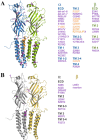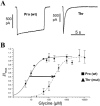Glycine receptor mouse mutants: model systems for human hyperekplexia
- PMID: 23941355
- PMCID: PMC3949644
- DOI: 10.1111/bph.12335
Glycine receptor mouse mutants: model systems for human hyperekplexia
Abstract
Human hyperekplexia is a neuromotor disorder caused by disturbances in inhibitory glycine-mediated neurotransmission. Mutations in genes encoding for glycine receptor subunits or associated proteins, such as GLRA1, GLRB, GPHN and ARHGEF9, have been detected in patients suffering from hyperekplexia. Classical symptoms are exaggerated startle attacks upon unexpected acoustic or tactile stimuli, massive tremor, loss of postural control during startle and apnoea. Usually patients are treated with clonazepam, this helps to dampen the severe symptoms most probably by up-regulating GABAergic responses. However, the mechanism is not completely understood. Similar neuromotor phenotypes have been observed in mouse models that carry glycine receptor mutations. These mouse models serve as excellent tools for analysing the underlying pathomechanisms. Yet, studies in mutant mice looking for postsynaptic compensation of glycinergic dysfunction via an up-regulation in GABAA receptor numbers have failed, as expression levels were similar to those in wild-type mice. However, presynaptic adaptation mechanisms with an unusual switch from mixed GABA/glycinergic to GABAergic presynaptic terminals have been observed. Whether this presynaptic adaptation explains the improvement in symptoms or other compensation mechanisms exist is still under investigation. With the help of spontaneous glycine receptor mouse mutants, knock-in and knock-out studies, it is possible to associate behavioural changes with pharmacological differences in glycinergic inhibition. This review focuses on the structural and functional characteristics of the various mouse models used to elucidate the underlying signal transduction pathways and adaptation processes and describes a novel route that uses gene-therapeutic modulation of mutated receptors to overcome loss of function mutations.
Keywords: domain complementation; glycine receptor; knock-in; mouse models; spontaneous.
© 2013 The British Pharmacological Society.
Figures





Similar articles
-
The impact of human hyperekplexia mutations on glycine receptor structure and function.Mol Brain. 2014 Jan 9;7:2. doi: 10.1186/1756-6606-7-2. Mol Brain. 2014. PMID: 24405574 Free PMC article. Review.
-
Glycine receptor mutants of the mouse: what are possible routes of inhibitory compensation?Front Mol Neurosci. 2012 Oct 31;5:98. doi: 10.3389/fnmol.2012.00098. eCollection 2012. Front Mol Neurosci. 2012. PMID: 23118727 Free PMC article.
-
A Novel Glycine Receptor Variant with Startle Disease Affects Syndapin I and Glycinergic Inhibition.J Neurosci. 2020 Jun 17;40(25):4954-4969. doi: 10.1523/JNEUROSCI.2490-19.2020. Epub 2020 Apr 30. J Neurosci. 2020. PMID: 32354853 Free PMC article.
-
Disruption of a Structurally Important Extracellular Element in the Glycine Receptor Leads to Decreased Synaptic Integration and Signaling Resulting in Severe Startle Disease.J Neurosci. 2017 Aug 16;37(33):7948-7961. doi: 10.1523/JNEUROSCI.0009-17.2017. Epub 2017 Jul 19. J Neurosci. 2017. PMID: 28724750 Free PMC article.
-
The genetics of hyperekplexia: more than startle!Trends Genet. 2008 Sep;24(9):439-47. doi: 10.1016/j.tig.2008.06.005. Epub 2008 Aug 15. Trends Genet. 2008. PMID: 18707791 Review.
Cited by
-
Disturbed neuronal ER-Golgi sorting of unassembled glycine receptors suggests altered subcellular processing is a cause of human hyperekplexia.J Neurosci. 2015 Jan 7;35(1):422-37. doi: 10.1523/JNEUROSCI.1509-14.2015. J Neurosci. 2015. PMID: 25568133 Free PMC article.
-
The Concise Guide to PHARMACOLOGY 2013/14: ligand-gated ion channels.Br J Pharmacol. 2013 Dec;170(8):1582-606. doi: 10.1111/bph.12446. Br J Pharmacol. 2013. PMID: 24528238 Free PMC article.
-
Identification of a stereotypic molecular arrangement of endogenous glycine receptors at spinal cord synapses.Elife. 2021 Dec 8;10:e74441. doi: 10.7554/eLife.74441. Elife. 2021. PMID: 34878402 Free PMC article.
-
The postnatal development of ultrasonic vocalization-associated breathing is altered in glycine transporter 2-deficient mice.J Physiol. 2019 Jan;597(1):173-191. doi: 10.1113/JP276976. Epub 2018 Nov 20. J Physiol. 2019. PMID: 30296333 Free PMC article.
-
Murine startle mutant Nmf11 affects the structural stability of the glycine receptor and increases deactivation.J Physiol. 2016 Jul 1;594(13):3589-607. doi: 10.1113/JP272122. Epub 2016 May 10. J Physiol. 2016. PMID: 27028707 Free PMC article.
References
-
- Akabas MH, Kaufmann C, Archdeacon P, Karlin A. Identification of acetylcholine receptor channel-lining residues in the entire M2 segment of the alpha subunit. Neuron. 1994;13:919–927. - PubMed
-
- Al-Futaisi AM, Al-Kindi MN, Al-Mawali AM, Koul RL, Al-Adawi S, Al-Yahyaee SA. Novel mutation of GLRA1 in Omani families with hyperekplexia and mild mental retardation. 2012;46:89–93. - PubMed
-
- Andermann F, Keene DL, Andermann E, Quesney LF. Startle disease or hyperekplexia: further delineation of the syndrome. Brain. 1980;103:985–997. - PubMed
-
- Balansa W, Islam R, Fontaine F, Piggott AM, Zhang H, Xiao X, et al. Sesterterpene glycinyl-lactams: a new class of glycine receptor modulator from Australian marine sponges of the genus Psammocinia. Org Biomol Chem. 2013a;11:4695–4701. - PubMed
Publication types
MeSH terms
Substances
LinkOut - more resources
Full Text Sources
Other Literature Sources
Molecular Biology Databases

